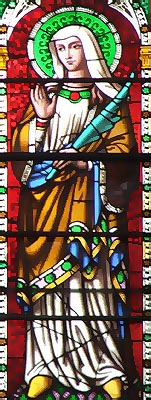
EBK Home
Kingdoms
Royalty
Saints
Pedigrees
Archaeology
King Arthur
Adversaries
Mail David
 St. Withburga
of Dereham,
St. Withburga
of Dereham, Abbess of Dereham
(Died AD 743)
Withburga was the youngest of the saintly daughters of Anna, King of East Anglia. Her sisters were SS.
Ethedreda and Sexburga; they had an elder half-sister
St. Saethrith and an illegitimate half-sister,
St. Ethelburga of Faremoutier-en-Brie. Withburga was also aunt of St. Ermengild. When a young girl, she was sent to live with her nurse at Holkham in Norfolk where, in process of time, a church was built in her honour and the place called Withburgstowe. After her father's death, she built a convent at East Dereham. While she was building it, she had, at one time, nothing but dry bread to give her workmen. She applied for assistance to the Blessed Virgin Mary who directed her to send her maids to a certain fountain every morning. There, they found two wild does which yielded plenty of milk. In this way, the workmen were fed and the work prospered until the overseer of those lands, in contempt or dislike of the saint and her miracles, hunted the does, with dogs, and made them leave off coming to the fountain to be milked. He was punished for his cruelty, for his horse threw him and he broke his neck.
Withburga died on 17th March AD 743 and was buried in the cemetery of the Abbey of Dereham and her body, being found uncorrupted fifty-five years afterwards, was translated into the church which she herself had built. In AD 974, Brithnoth, Abbot of Ely, determined to lay the body beside those of her sisters. He went, with armed followers, to Dereham where he invited the townsmen to a feast and made them drunk. He carried off the body. They awoke and went in pursuit, and the men of Ely and the men of Dereham fought lustily for their treasure. Javelins wore thrown and hard blows were exchanged. At last, however, Brithnoth triumphantly carried off the saint and deposited her at Ely.
Edited from Agnes Dunbar's "A Dictionary of Saintly Women" (1904).
